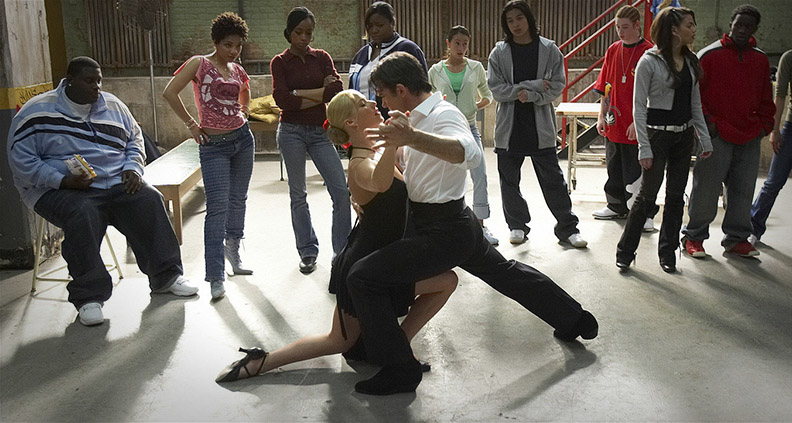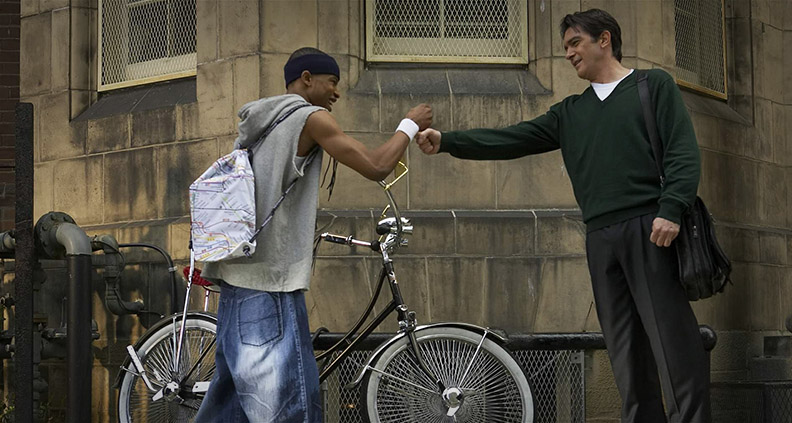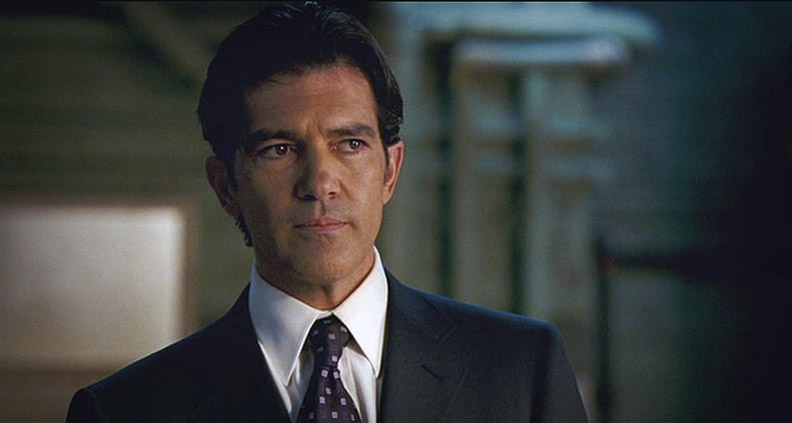Take the Lead (2006 dir. Liz Friedlander)
“The man proposes the step. It is the woman’s choice to accept by following. To follow takes as much strength as to lead.” –Pierre Dulaine (Antonio Banderas) When I first heard this simple-yet-poignant line from Banderas’s lead character in the 2006 drama Take The Lead, I knew the film would be a different kind of dance movie. Inspired by the true story of Pierre Dulaine, the famous Palestinian-born British ballroom dancer and instructor, director Liz Friedlander’s film takes us through Dulaine’s 1994 initiative (“Dancing Classrooms”—more on this below) aimed at bringing ballroom dancing to underprivileged students in the New York public school system, using dance as a way to instill the values of respect, dignity, self-esteem, teamwork and empathy. The line quoted above is Dulaine’s explanation to a young woman who is at first resistant of the idea of allowing her male dance partner to dictate every move, which some might argue is a feeble attempt to introduce female empowerment ideals (ex post facto) into the realm of traditional partner dance. Nonetheless, the words ring true at some level, in certain situations, when it comes to relationships. After a chance encounter on the streets of New York, Dulaine discovers a group of delinquents in detention at an inner city high school and promptly pitches an alternate disciplinary solution to the school’s principal, played by Alfre Woodard: ballroom dancing to the rescue! As one can imagine, the kids initially reject the idea and laugh at him. Nor are the school administrators supportive of him either, never mind that he’s offering to teach detention for free. After all, what kind of highfalutin star-gazer would believe he could teach the rumba, foxtrot and tango to a group of inner-city high schoolers more attuned to the bump-and-grind (not to mention hip hop and rap)?
‘Take the Lead’ (2006)But soon, Dulaine figures out what makes his kids tick (spoiler alert: it’s sex) and brings his best student from his uptown dance studio to do an Argentine Tango demo with him to show the class. His sultry Tango wins the kids over and the class is motivated to join a dance competition, cash prize $5,000. But before we get to the final competition, one particularly annoying and pessimistic teacher leads a revolt against Pierre’s method by pitting the parents (who are constantly plagued by concerns of teen pregnancy, drugs, alcohol and sexual abuse) against him at a PTA meeting. But Dulaine’s eloquent response convinces them that he knows what he’s doing: “If she allows me to lead, she’s trusting me. But more than that, she’s trusting herself. If your 16-year-old daughter is strong and secure and trusts herself, how likely is she to let some idiot knock her up? And if your son can learn to touch a girl with respect, how will he treat women throughout his life?”
Further Study Watching Take the Lead 10 years ago, I had wondered if any of this story was true. Could ballroom dancing be taught in such a way as to impart important values to adolescent minds craving acceptance and belonging? And How far did the initiative go? Did it spread beyond the public schools in New York City? When the real-life Dulaine was asked why he wanted to help the kids of New York’s public school system, his answer was so simple and well intentioned that it took me by surprise. According to him, dancing had brought nothing but joy and prosperity to his life ever since he started at 14-years-old in Birmingham, UK. He wanted to give back and dancing was the only way he knew how. This led to the creation of Dancing Classrooms in 1994 with Dulaine’s longtime ballroom partner Yvonne Marceau, which soon spread throughout New York’s five boroughs, and which was also chronicled in the 2005 documentary Mad Hot Ballroom, which acts as a terrific companion piece to Friedlander’s film, following three pairs of fifth graders through their 10-week training on their way to the grand competition. The instructor also devised the “Dulaine Method” of teaching ballroom dance, which encompasses the following principles:
Respect and compassion (participants are addressed as “Ladies and Gentlemen”) Being present (emphasizing the “here and now” to engage the students) Creating a safe space (classes are meant to some place where the kids feel safe and respected) Command and control (use the group to help the individual) Verbal and body language (openness, warmth, genuine affection and positive reinforcement) Humor and joy (lessons are conducted in a way so that the students can grasp that dance is meant to be fun!)
Dulaine’s teaching methods have since spread to more than 500 schools in over 24 US cities, and internationally in locations including Jordan and Switzerland. Unsurprisingly, the impact of this program to the participating school communities is difficult to measure. But according to Dancing Classroom’s 2015 Annual Report:
80% of participating schools have reported positive impact to academic performance 83% of participating schools have noted a drop in behavioral issues amongst their student body
According to Los Angeles Teaching Artist for the program Baja Poindexter, the program has done great things for her students at West Athens Elementary School. “They’re at a disadvantage, and, at some point, they realize they’re at a disadvantage,” she said in an interview with The Atlantic. “Will dance keep them away from some of these negative things? I do believe that, and that’s why I teach.” In a world that increasingly mirrors the headlines we see in post-apocalyptic movies just before an alien invasion or a nuclear war thrusts much of humanity into a dystopian existence, a feel-good dance drama like Take the Lead comes along and restores our hope in humanity. Some people out there really are trying to do some good for others. To learn more about Film Independent, subscribe to our YouTube channel or follow us on Twitter and Facebook. To learn how to become a Member of Film Independent, just click here.


